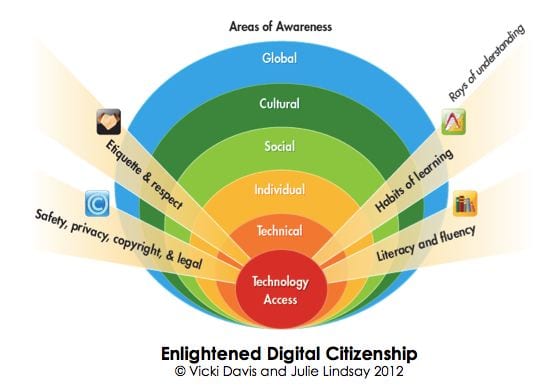- What is your definition of digital citizenship?
- What is your stance on digital citizenship?
- What should an informed, publicly engaged digital citizen look like?
- What direction are you (or your school) taking?
My initial definition of digital citizenship: As students participate in DEs, they require certain skills and attitudes (digital citizenship) to navigate, interact and create ethically in a way that leaves a positive digital footprint. Digital users need to be fluent, ethical, and effective digital citizens. In this way they exhibit citizenry skills that “uphold standards for legal, ethical, safe, responsible, and respectful uses of technology” (Greenhow, 2010, p. 25). As identified by Mike Ribble and Gerald Bailey, digital citizenship skills can be organised in three categories; respect, educate, protect (Ribble, 2011). At present, my library embeds digital citizenship skills into the research, assignment help, and IT help sessions. Topics including copyright and use of creative commons, digital footprint, and safe online behaviour are covered however, this just scratches the surface of what it means to be an effective digital citizen. We have recently added the concept of cognitive bias and lateral reading to our research sessions to develop students’ digital information literacy skills. Cognitive bias is of particular importance with the prevalence of fake news and clickbait bulletins. An understanding of cognitive bias encourages students to consider their approach to research, their selection of sources, and their assessment of validity. While the technique of lateral reading equips students with the skills to effectively and efficiently determine the validity of their sources similar to the approach used by fact checkers (Wineburg & McGrew, 2017). Lindsay and Davis (2012) describe digital citizenship approaches as a series of awarenesses. These areas of awareness – technical, individual, social, cultural, global – are combined with “rays of understanding” that determine the relevant behaviours required to respond to various situations. Lindsay and Davis (2012) present this interrelationship as enlightened digital citizenship as seen in Figure 1. Importantly, as with any skills-based program, these understandings and awarenesses should be developed through embedded practices that are contextualised and just-in-time (Marrs, 2016). At this point, we have more room to grow and must make space to explicitly cover these skills in more depth using an embedded methodology.

Reference
Greenhow, C. (2010). New concept of citizenship for the digital age. Learning & Leading with Technology, 37(6), 24-25. Retrieved from EBSCO Host.
Marrs, H. (2016). Don’t teach digital citizenship – embed it! Retrieved from https://www.iste.org/explore/In-the-classroom/Don
Wineburg, S. & McGrew, S. (2017). Lateral reading: Reading less and learning more when evaluating digital information [Report]. Retrieved from https://papers.ssrn.com/sol3/papers.cfm?abstract_id=3048994
[Reflection: Module 1.1]